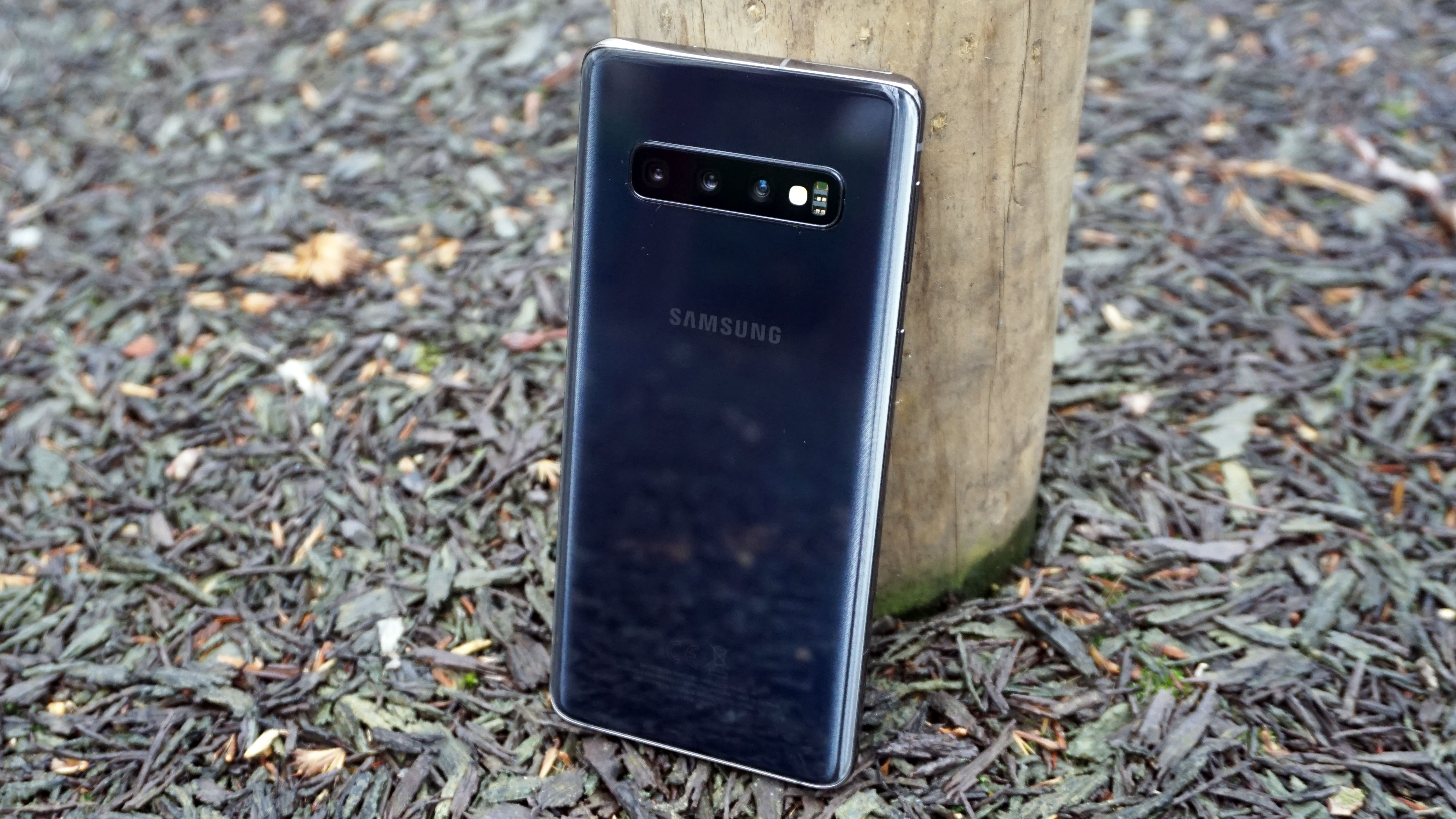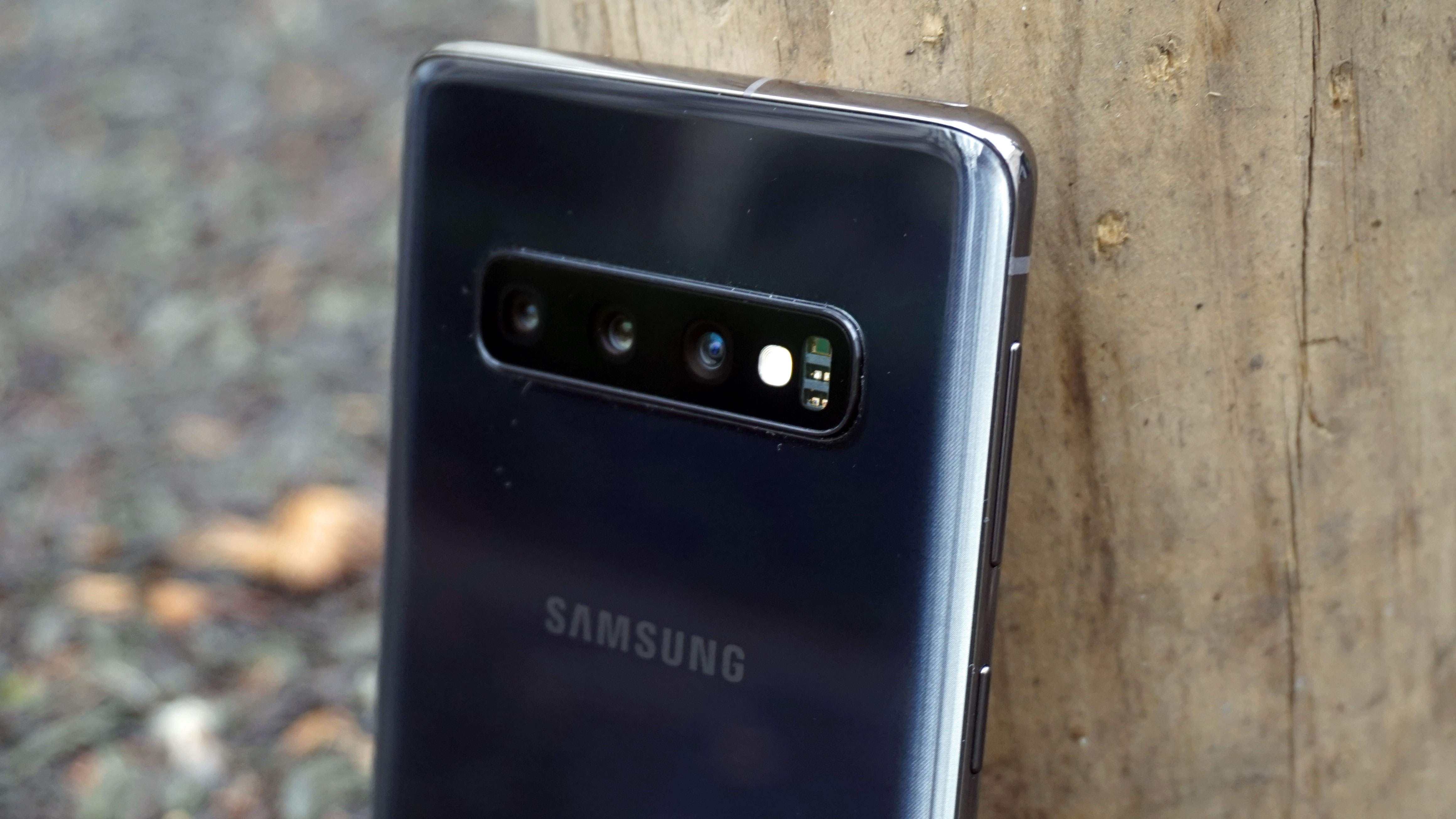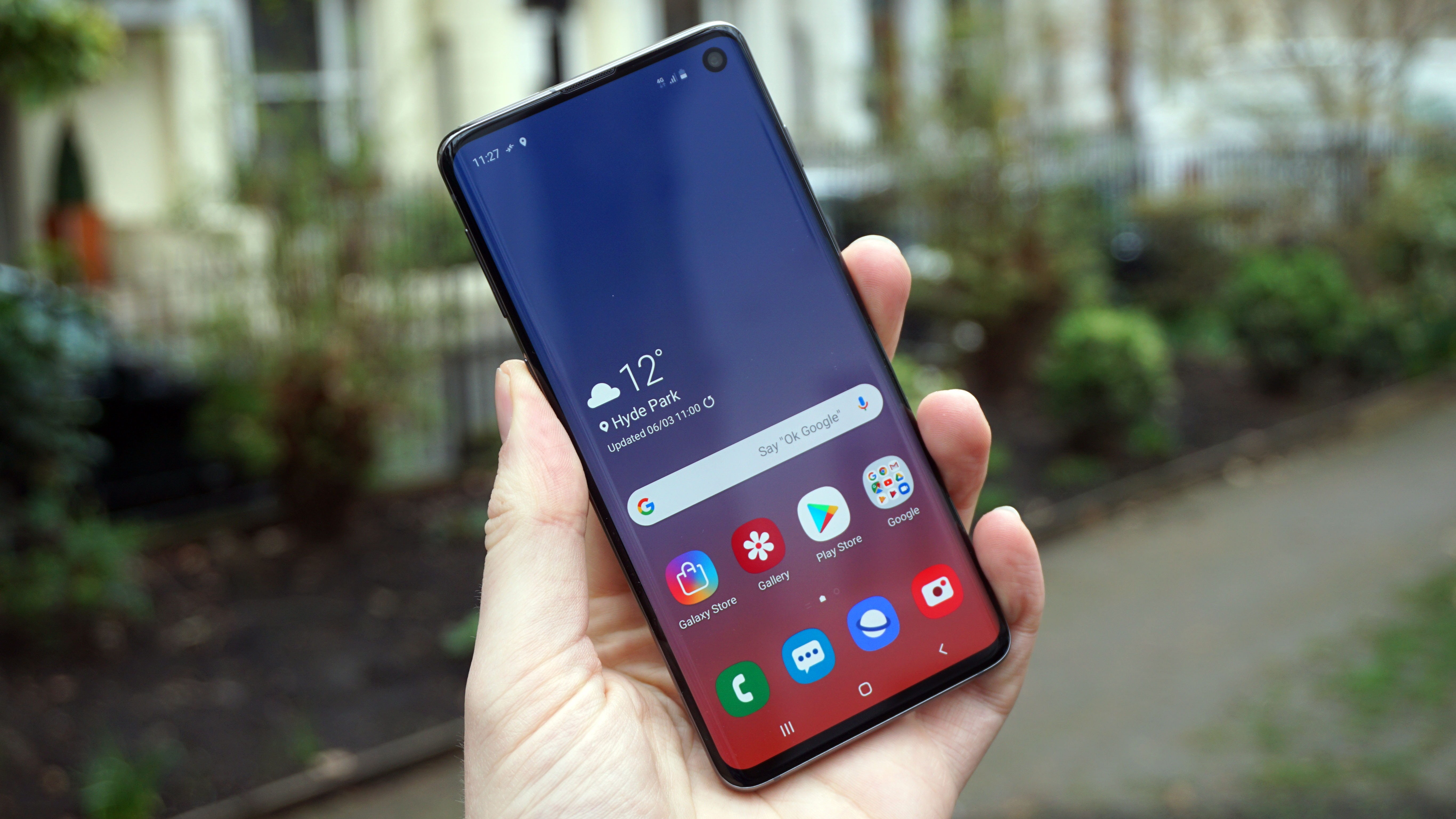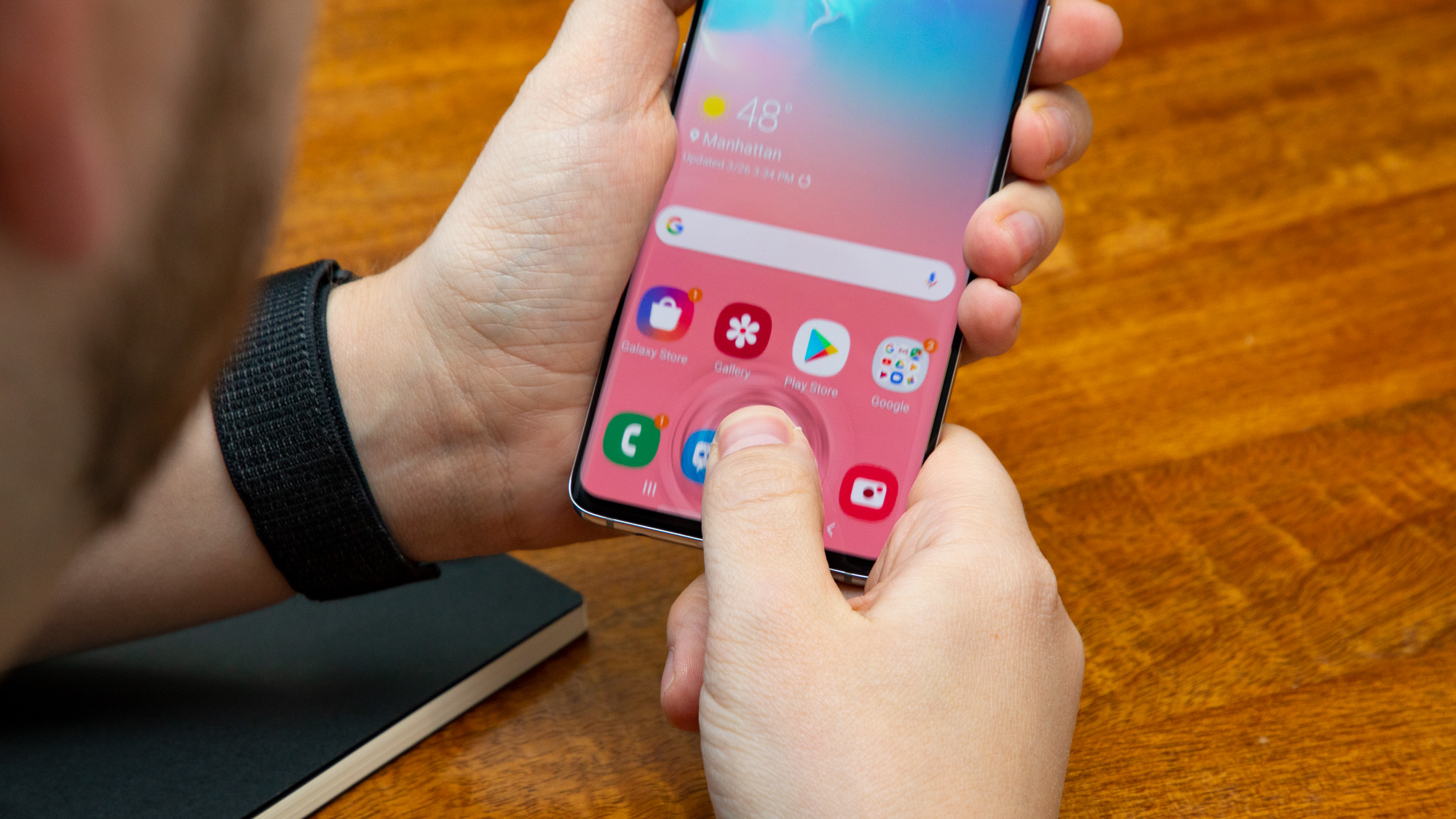TechRadar Verdict
The Samsung Galaxy S10 is a fitting 10th anniversary phone for Samsung and its storied S series. It delivers on change with a novel-looking Infinity-O screen so large it displaces the front camera, and a triple-lens rear camera that takes ultra-wide photos. Its in-screen fingerprint sensor tech should serve you well, while its Wireless PowerShare could serve your friends well. That’s a lot of change – just know that it comes at a high price and the Galaxy S10e and S10 Plus flank it from both sides of the coin as better options.
Pros
- +
High screen-to-body ratio
- +
In-screen fingerprint sensor
- +
Wireless PowerShare perk
Cons
- -
Stunning price hike
- -
S10e and S10 Plus are better
- -
Great camera, but not the best
Why you can trust TechRadar
The Samsung Galaxy S10 is engineered and designed to be a conversation-changer, a phone that's crafted to turn everyone's yearly question of "Do I really need to upgrade?" into a more exclamatory "I really need to upgrade!"
The S10 remains a powerful and attractive phone even after it's been surpassed by the Samsung Galaxy S20, the Galaxy S21, and the Samsung Galaxy S22, all with 5G capability, improved cameras, and faster speeds than ever. If you don't need the absolute latest and greatest, this older flagship remains a great device with specs and cameras that will still be competitive.
So the Galaxy S10 is far from the newest phone from the brand, and nor is it one of the best phones or even one of the best Samsung phones anymore but - as our Samsung Galaxy S10 review will show - it remains a powerhouse, especially at the discounts it's getting years after its release.
There's also another budget phone in the lineup, the Samsung Galaxy S10 Lite, with a massive 6.7-inch screen with even more cameras than the S10e, plus a few upgrades. But it's been surpassed by the Samsung Galaxy S20 FE, which is the latest affordable flagship king.
In its prime, the 6.1-inch Infinity Display really set the Samsung Galaxy S10 apart. The handset introduces a nearly-edge-to-edge look that stretches top to bottom, with pixels spilling over the curved edges at the sides – there's no room for big bezels on Samsung's new smartphone. For the most part, bezels don't exist here.
Its new Infinity-O screen – also a feature of the bigger Galaxy S10 Plus and cheaper Galaxy S10e – is so large it actually displaces the front camera, consigning it to a small 'punch-hole' in the screen. All of the important sensors are neatly tucked behind this vibrant and bright Super AMOLED display.
Also behind the glass is the new ultrasonic fingerprint sensor. You won't find a fingerprint pad on the back anymore, or anywhere visibly on the phone. Samsung put its sensor – now invisible – on the front, where we feel it belongs.
Sign up for breaking news, reviews, opinion, top tech deals, and more.

The Samsung S10 officially makes punch-hole displays a trend after the idea debuted on the Honor View 20, and in-screen fingerprint sensors more mainstream after they appeared on the OnePlus 6T, Huawei Mate 20 Pro and a few Vivo phones.
It’s all designed to achieving that impressive 93.1% screen-to-body ratio on the front of the phone. And, frankly, we like it a bit better than a traditional notch. So far, only the selfie camera on devices like the OnePlus 7 Pro offer a cleaner-looking alternative on a very similar curved display. But Samsung's punch-hole won't bug you after a couple of hours with the Galaxy S10.
Maximization is also the idea behind the Samsung S10's rear-facing triple-lens camera. Samsung’s camera array has lenses to take normal, telephoto and new ultra-wide photos. The ultra-wide camera is all about capturing more of what’s in front of you without having to back up.
Sure, LG phones have touted ultra-wide camera lenses for years, like the LG V40, but Samsung’s cameras have been more consistent in low-light conditions. The feature is finally in a flagship-level phone you want.
The Samsung S10 also has features everyone can get. Its Wireless PowerShare feature lets you use the back of the S10 to Qi charge another phone or the new Galaxy Buds, cloning the reverse wireless charging idea in the Huawei Mate 20 Pro, a phone that’s not widely available in certain territories, including the US.
The Samsung S10 is an amalgam of other handsets’ single hallmark features packed into one phone, while Samsung pioneers as many technical features as it can cram in – faster Wi-Fi 6 and HDR10+ are both firsts for smartphones. And that’s what Samsung does best really.
The Samsung Galaxy S10 marks a decade of Galaxy S phones, and while there’s been little innovation in recent years from the most popular smartphone brands, including Samsung (Bixby and AR EMoji don’t cut it), the S10 has enough newness to tempt you to upgrade.
What's not to like? Well, if you can handle the Samsung Galaxy S10 Plus size, it's our No. 1 pick thanks to its extra battery life, bigger screen and better performance as a gaming phone – and the price hike isn't so terrible. And if you're considering the S10 to save money or want a smaller screen, the better value is in the 5.8-inch S10e. Samsung has the best phones for 2019 (so far), but its biggest competition is none other than Samsung.
Samsung Galaxy S10: release date and price
- Launched in March, 2019
- Official start price is $749 / £669 / AU$1,149

Weight: 157g
Dimensions: 149.9 x 70.4 x 7.8mm
Pre-installed software: Android 9
Screen size: 6.1-inch
Resolution: QHD+
CPU: Octa-core chipset
RAM: 8GB
Storage: 128/512GB
Battery: 3,400mAh
Rear camera: 16MP + 12MP + 12MP
Front camera: 10MP
The Samsung Galaxy S10 release date was Friday, March 8 and it was announced on February 20, with pre-orders opening right away in some countries. In the US, Galaxy S10 pre-orders started on February 21. Now that its successor has launched, the S10's price has been discounted.
There's a hitch or two in Samsung's masterplan to get everyone to upgrade to this particular handset. The Samsung S10 launch price was expensive, more so than the Galaxy S9, although it's markedly better value than the iPhone XS, which was more expensive and has a smaller 5.8-inch screen.
The Galaxy S10e is cheaper and almost as good, while the Galaxy S10 Plus is the phone you’ll want if you can handle its price and screen size – and that’s to say nothing of the Galaxy S10 5G and the Samsung Galaxy Fold, which started at an even higher price.
The Samsung Galaxy S10 price now starts at $749 / £669 / AU$1,149 / AED 3,199 for the 128GB of storage model, meaning you're spending an additional $180 / £60 / AED 100 on this phone over the S9 launch price.

If you need more storage (and don't want to use the microSD slot inside the Galaxy S10) you can opt for the 512GB model which costs $1,149 / £999 / AU$1,699.
If you like the look of this phone but think that price is a tad high realize that Apple charges $100 / £200 / AU$430 more for the smaller 5.8-inch iPhone XS with half the internal storage, 64GB.
In certain timely sales and deals, you can sometimes find the Galaxy S10 for up to half price its initial launch price, but these discounts are far from reliable, as they can often be hard to find.
Samsung Galaxy S10: display
- 6.1-inch AMOLED screen
- 1440 x 3040 resolution
Samsung’s screens are so good "our competitors are even using them", Samsung brand manager Paul Guzek told TechRadar, an all-too-obvious dig at Apple. It's hard to disagree.
In fact, the Samsung S10's 6.1-inch 19:9 Super AMOLED display panel looks better than anything Samsung sells its rivals, and it's been crowned the most color accurate smartphone display ever.
It has elegantly curved edges with pixels that spill over the sides, amped-up brightness for better outdoor visibility, and HDR10+ support for superior contrast and color.
There's a QHD+ resolution too, which creates a pixel density of 550ppi, ensuring everything on screen is highly detailed. However, the phone defaults to Full HD+, which looks as good and you probably won't notice a difference on a phone this size, unless you're using it for VR two inches from your face. It also saves battery life by burning fewer pixels.

The new Infinity-O display type is what stands out – for better or worse. Samsung has successfully avoided a notch cut-out at the top of its flagship phones, instead using a laser-cut hole in the top-right corner of the screen to embed the front-facing camera, as on the Honor View 20.
Is a 'punch-hole' camera more or less distracting than a notch? From our time with the Samsung S10 so far, we'd say less. It sits comfortably to the right in the notification bar, providing plenty of space for the time, battery and connectivity icons, as well as any notifications you may have.
It’s also given Samsung more screen real estate to play with than ever, and don’t let the bigger 6.1-inch screen size scare you off.
The S10’s dimensions are 149.9 x 70.4 x 7.8mm (and it weighs 157g), so it’s only marginally taller and wider than the S9 with its 5.8-inch screen, and noticeably thinner and a bit lighter.
Those marginal increases in height and width are due to the Samsung S10’s screen-to-body ratio of 93.1% (the S9 was 83.6%). The S10 Plus sports that 6.4-inch screen with the same screen-to-body ratio and a nice size if you can handle it. However, if you're wary of false corner touches (especially when typing) due to the bezel-less edges, stick with the normal S10.
Bezel does outline the top and bottom of this display, even if we said it wasn’t big. Samsung’s top speaker still reigns, and there’s a thin but noticeable chin across the bottom; it’s less bezel rather than bezel-less.
And the fact that the bottom bezel is larger than the top one catches our eye – it may be more distracting than the punch-hole.
There’s little to dislike regarding the new display – if the Infinity-O doesn’t distract day-to-day, and as mentioned we’ll update this review when we have more hands-on time with the S10.
Samsung Galaxy S10: design
- Glass back and metal frame
- Fits well in the palm of your hand
You’re not going to be overly surprised by the rest of the Samsung Galaxy S10 design, though there are a few notable enhancements, two hidden surprises, and an old classic here.
Its thinner aluminum frame is sandwiched between smooth glass, with the back coming in your choice of color: Flamingo Pink, Prism Black, Prism Blue, Prism White, Canary Yellow and Prism Green. Samsung Galaxy S10 colors will vary by region, with the US getting all but yellow and green.

There’s the smallest of camera bumps on the back, housing the triple-lens camera array, while we saw no signs of Samsung’s invisible reverse wireless charging module below this. It’s a particularly clean look in a world of camera bumps and rear-fingerprint sensors.
We had no difficulty activating Samsung’s Wireless PowerShare feature after turning it on via the quick settings notification shade. We placed our Galaxy Buds case on the lower third of the S10 back and the earbuds began charging almost instantly. It even charged our iPhone XS Max.
Samsung laid out two scenarios in which Wireless PowerShare would be helpful: charging a friend’s phone, or charging your Galaxy Buds at night, effectively making your plugged-in S10 a mobile Qi charger pad. Samsung noted, though, that PowerShare won’t work when the phone is below 30%.
Possibly the best bit about the Samsung Galaxy S10 though is its size. As we've already mentioned, it measures 149.9 x 70.4 x 7.8mm, and considering the size of the screen is nestles surprisingly well in the palm.
View our Samsung Galaxy S10 hands-on gallery

















It's possible to use the Samsung S10 one-handed, with the curved edges on the front and rear helping to give the effect that the phone is narrower than it actually is.
That said, the glass and metal body doesn't offer up a huge amount of grip, so if you're accident prone we'd recommend picking up a case - even if it's just a slim silicon job - to provide extra traction in your hand.
Also invisible – this time around the front – is the fingerprint sensor. While a lot of Android phones have used a rear-facing fingerprint sensor, Samsung stuck with the front-facing physical sensor pad all the way up to the Galaxy S7.
So the switch to the back felt foreign on Samsung phones – but it’s come back to the front in the S10, this time tucked underneath the glass.
This is an ultrasonic fingerprint sensor, different from the optical sensors on the OnePlus 6T and Huawei Mate 20 Pro, for example.
Samsung uses Qualcomm-backed tech that’s said to be better, and more secure, by making a 3D scan of your print, plus it'll work if your fingers are wet or cold - two scenarios optical scanners struggle with.

It works reasonably well, but it's not a fast as an optical fingerprint scanner. You won't be left waiting - it still takes less than a second to read, register and unlock the S10, but it lacks the zip of scanners not embedded in the display.
There also seems to be a slightly higher failure rate too. You need to be precise with your finger placement, and you'll need to apply a little pressure for it to work. It takes a little getting used to, but things do improve.
And here’s a welcomed classic that hasn’t changed since the first S phone a decade ago: the 3.5mm headphone jack.
Samsung is one of the few phone makers that includes the standard headphone jack in 2019 – and it’s doing it despite introducing the wireless Galaxy Buds and reducing the thickness of the Galaxy S10.
- Take a look at our Samsung discount codes for the best Samsung offers and savings.

- John McCannFormer Global Managing Editor
